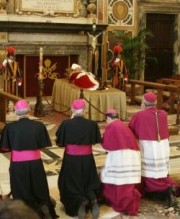

|
|
| Musical Musings: Prayers and Liturgical Texts | Page 2 |
Litaniæ sanctorum (Part 2)The Litany of the Saints as sung in Rome on April 4, 2005 There are many forms for the Litany of the Saints.
Perhaps the most familiar is the abbreviated version sung before the Blessing of Water at the Easter Vigil Liturgy.
This begins with a short list of saints (including the names of the baptismal candidates and their confirmation names) and various invocations.
The Litany of the Saints is also specified for use during the Ordination Rite for Deacon, Priests and Bishops.
Other more complete forms are (were) used at Forty Hours devotions, Rogation Days, and various processions.
These included an expanded list of saints, more invocations and prayers (similar to the General Intercessions at Mass) and even Psalm 70 and numerous collects.
There are many forms for the Litany of the Saints.
Perhaps the most familiar is the abbreviated version sung before the Blessing of Water at the Easter Vigil Liturgy.
This begins with a short list of saints (including the names of the baptismal candidates and their confirmation names) and various invocations.
The Litany of the Saints is also specified for use during the Ordination Rite for Deacon, Priests and Bishops.
Other more complete forms are (were) used at Forty Hours devotions, Rogation Days, and various processions.
These included an expanded list of saints, more invocations and prayers (similar to the General Intercessions at Mass) and even Psalm 70 and numerous collects.
In the Order of Christian Funerals, during the Transferal of the Body from the home to the church, it is common to chant the Litany of the Saints. Part of what captivated the vast audience watching this rite from Rome was the Latin language used for the litany. As the Papal Gentlemen (from noble families in Rome) bore the body of the dead pontiff from his home (the Apostolic Palace) to the church (Saint Peter's Basilica), the Sistine Choir led the cardinals and the faithful in the Litaniæ sanctorum. What made this unusual, even to ears accustomed to hearing the litany and the Latin language, was the personalization of the text. Rather than the usual response to each saint's invocation, Ora pro nobis, meaning "Pray for us," this litany used Ora pro eo, meaning "Pray for him." Further, the list of saints was expanded to include the canonized popes, beginning with Saints Peter, Linus and Cletus (the first three popes) and continuing through Pope Saint Pius X from the 20th century. How to use the Litany of the Saints in Your Parish The Litany of the Saints can easily be sung in English or in Latin, and occurs in the liturgy at least once a year at the Easter Vigil.
Further, because of its flexibility, it can easily be adapted to a great variety of occasions, adding or deleting names and invocations as circumstances warrant.
With simple responses that are repeated frequently, it is ideal music for children (we've sung the Litany of the Saints to open the school year, using the patron saints – according to their first or middle names – of all the children in the school).
The Litany of the Saints can easily be sung in English or in Latin, and occurs in the liturgy at least once a year at the Easter Vigil.
Further, because of its flexibility, it can easily be adapted to a great variety of occasions, adding or deleting names and invocations as circumstances warrant.
With simple responses that are repeated frequently, it is ideal music for children (we've sung the Litany of the Saints to open the school year, using the patron saints – according to their first or middle names – of all the children in the school).
The Litany of the Saints can be sung in English or Latin at Mass on the Solemnity of All Saints, for the Commemoration of the Faithful Departed (All Souls Day), as the Entrance Song at Mass on Advent I or Lent I, for Corpus Christi or any other procession. Some online sources for the litany text:
This version is used at the Easter Vigil before the Blessing of Water. It is scored with text in Latin and music in modern notation and can be sung a cappella, either in unison throughout, or by adding SATB harmonies on the verses. The organ may also accompany the responses, if desired. |